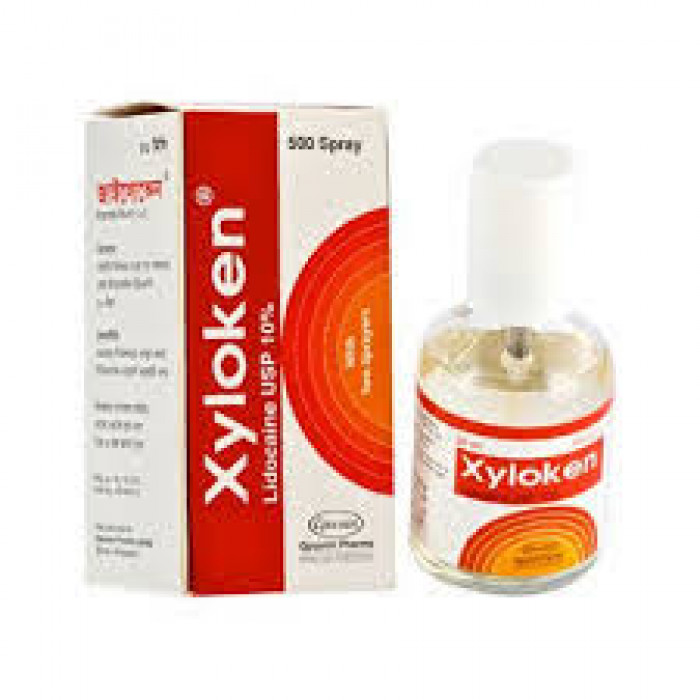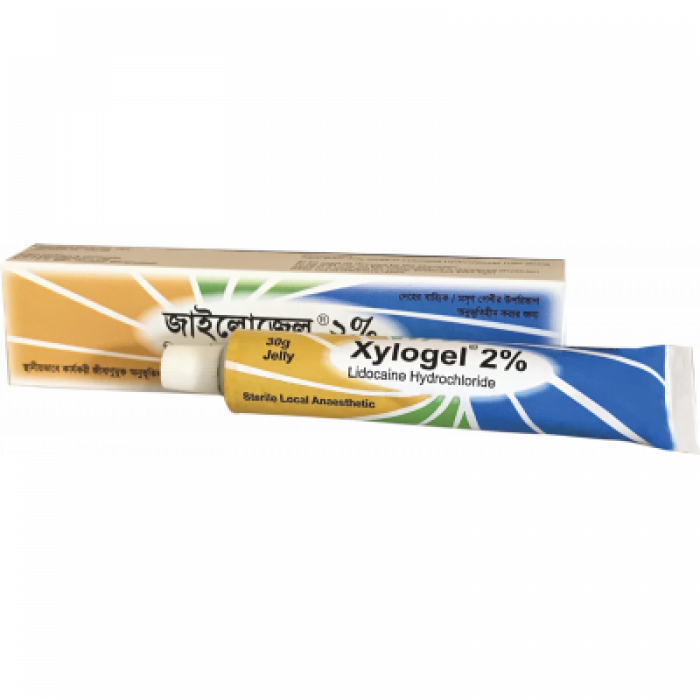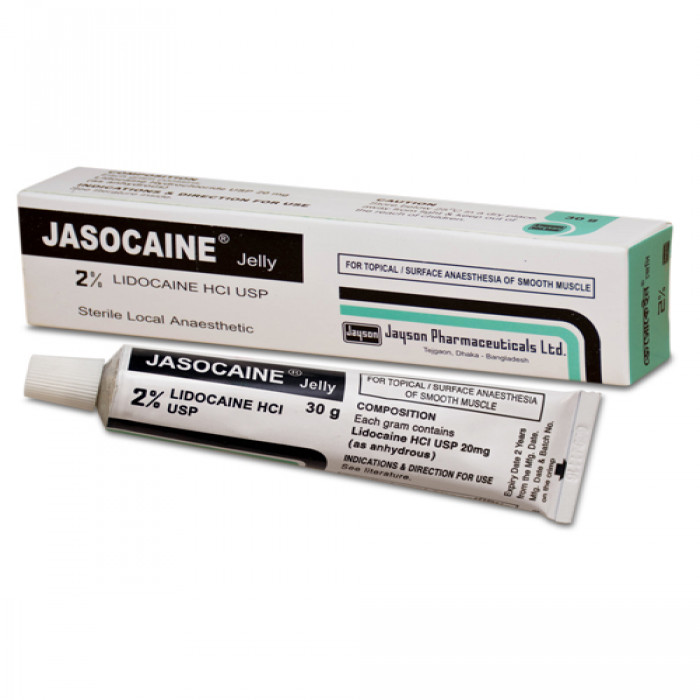
✔ 100% Authentic Product
👁️ Currently Viewing 5418
✅ Description:
MedEasy


Xyloken50 ml
Spray
Lidocaine Hydrochloride
Opsonin Pharma Ltd.
MRP ৳ 451.00
10% Off
Best PriceTk 405.90
/500 Spray Bottle
500 Spray Bottle
button-minus1button-plus
Add to cart
Medicine overview
English
Indications of Xyloken 50 ml
Lidocaine Injection is indicated- As a local anaesthetic for use in infiltration blockade and intravenous regional analgesia. For the prevention and treatment of ventricular tachyarrhythmias
Theropeutic Class
Local & Surface anesthesia
Pharmacology
Lidocaine acts mainly by inhibiting sodium influx through sodium specific ion channels in the neuronal cell membrane, in particular the so called voltage-gated sodium channels. When the influx of sodium is interrupted, an action potential cannot arise and signal conduction is inhibited. The receptor site is thought to be located at the cytoplasmic (inner) portion of the sodium channel. Lidocaine binds more readily to sodium channels in activated state, thus onset of neuronal blockade is faster in neurons that are rapidly firing. This is referred to as state dependent blockade.
Dosage of Xyloken 50 ml
The dosage is adjusted according to the response of the patient and site of administration.Adult: For healthy adults, the maximum individual dose should not exceed 4.5mg/kg of body weight and in general it is recommended that the maximum total dose does not exceed 300 mg. Recommended doses given in the below serve only as a guide to the amount of anaesthetic required for most routine procedures.Infiltration- Percutaneous: Total dose 5-300 mg Intravenous regional: Total dose 50-300 mg Peripheral Nerve Blocks- Brachial: Total dose 225-300 mg Dental: Total dose 20-100 mg Intercostal: Total dose 30 mg Paravertebral: Total dose 30-50 mg Pudenal (each side): Paracervical Obstetrical analgesia: Total dose 100 mg Sympathetic Nerve Blocks Cervical: Total dose 50 mg Lumbar: Total dose 50-100 mg Central Neural Blocks Epidural: Total dose 200-300 mg [Dose determined by number of dermatomes to be anesthetized (2-3 mL/dermatome) periodically.] Thoracic: Total dose 200-300 mg Lumbar Analgesia: Total dose 250-300 mg Anesthesia: Total dose 200-300 mg Caudal Obstetrical analgesia: Total dose 200-300 mg Surgical anesthesia: Total dose 225-300 mg.
Administration of Xyloken 50 ml
Antiarrhythmic treatment: An intravenous dose of 1 mg.kg-1 may be given over 2 min and repeated after 5 min, but giving an infusion of 2-4 mg.min-1 to produce a plasma level of 2-4 mg. l-1 is a more satisfactory technique. To avoid a long delay in achieving a steady state, a loading dose of approximately 1 mg.kg-1 is usually given intravenously over 2 min at the outset.
Interaction of Xyloken 50 ml
Cimetidine can impair the metabolism of lidocaine absorbed into the circulation. Elimination will be delayed and the risk of adverse reactions increased. Significant increases in plasma lidocaine concentrations have occurred during concomitant therapy with beta blockers such as propranolol, metoprolol or nadolol. It prolongs the duration of action of suxamethonium.
Contraindications
Known hypersensitivity to anaesthetics of the amide type.
Side Effects of Xyloken 50 ml
In common with other local anaesthetics, adverse reactions to lidocaine are rare and are usually the result of excessively high blood concentrations due to inadvertent intravascular injection, excessive dosage, rapid absorption or occasionally to hypersensitivity, idiosyncracy or diminished tolerance on the part of the patient. In such circumstances systemic effects occur involving the central nervous system and/or the cardiovascular system. CNS reactions are excitatory and/or depressant and may be characterized by nervousness, dizziness, blurred vision and tremors, followed by drowsiness, convulsions, unconsciousness and possibly respiratory arrest. Cardiovascular reactions are hypotension, myocardial depression, bradycardia and possibly cardiac arrest. Allergic reactions are extremely rare. They may be characterized by cutaneous lesions, urticaria, oedema or anaphylactoid reactions.
Pregnancy & Lactation
Although there is no evidence from animal studies of harm to the foetus, as with all drugs, it should not be given during early pregnancy unless the benefits are considered to outweigh the risks. Caution should be exercised when it is administered to a nursing woman.
Precautions & Warnings
Lidocaine for infiltration and nerve block should be employed only by clinicians who are well versed in diagnosis and management of dose-related toxicity. The safety and effectiveness of lidocaine depend on proper dosage, correct technique, adequate precautions, and readiness for emergencies. Standard text books should be consulted for specific techniques and precautions for various regional anaesthetic procedures. Resuscitative equipment, oxygen and other resuscitative drugs should be available for immediate use.It should be used cautiously in patients with epilepsy, impaired cardiac conduction, bradycardia, impaired respiratory function and in patients with impaired hepatic function, if the dose or site of administration is likely to result in high blood levels. The effect of local anaesthetics may be reduced if an injection is made into an inflamed or infected area. Repeated doses of lidocaine may cause significant increases in blood levels with each repeated dose because of slow accumulation of the drug or its metabolites. Tolerance to elevated blood levels varies with the status of the patient. Careful and constant monitoring of cardiovascular and respiratory vital signs and the patient's state of consciousness should be accomplished after each local anaesthetic injection.
Storage Conditions
Keep below 25°C temperature, away from light & moisture. Keep out of the reach of children.
⚠️Disclaimer:
At ePharma, we’re committed to providing accurate and accessible health information. However, all content is intended for informational purposes only and should not replace medical advice from a qualified physician. Please consult your healthcare provider for personalized guidance. We aim to support, not substitute, the doctor-patient relationship.








